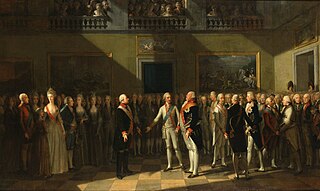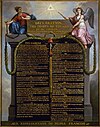
Jean Sylvain Bailly was a French astronomer, mathematician, freemason, and political leader of the early part of the French Revolution. He presided over the Tennis Court Oath, served as the mayor of Paris from 1789 to 1791, and was ultimately guillotined during the Reign of Terror.

Marie-Joseph Paul Yves Roch Gilbert du Motier de La Fayette, Marquis de La Fayette, known in the United States as Lafayette, was a French aristocrat, freemason, and military officer who volunteered to join the Continental Army, led by General George Washington, in the American Revolutionary War. Lafayette was ultimately permitted to command Continental Army troops in the decisive siege of Yorktown in 1781, the Revolutionary War's final major battle that secured American independence. After returning to France, Lafayette became a key figure in the French Revolution of 1789 and the July Revolution of 1830 and continues to be celebrated as a hero in both France and the United States.

The royal Flight to Varennes during the night of 20–21 June 1791 was a significant event in the French Revolution in which King Louis XVI of France, Queen Marie Antoinette, and their immediate family unsuccessfully attempted to escape from Paris to Montmédy, where the King wished to initiate a counter-revolution by joining up with royalist troops. They escaped as far as the small town of Varennes-en-Argonne, where they were arrested after being recognized at their previous stop in Sainte-Menehould.

The National Constituent Assembly was a constituent assembly in the Kingdom of France formed from the National Assembly on 9 July 1789 during the first stages of the French Revolution. It dissolved on 30 September 1791 and was succeeded by the Legislative Assembly.

The following is a timeline of the French Revolution.
The French Revolutionary Wars began on 20 April 1792 when the French Legislative Assembly declared war on Austria. This launched the War of the First Coalition.

The French Revolution was a period in the history of France covering the years 1789 to 1799, in which republicans overthrew the Bourbon monarchy and the Roman Catholic Church in France perforce underwent radical restructuring. This article covers the one-year period from 1 October 1791 to September 1792, during which France was governed by the Legislative Assembly, operating under the French Constitution of 1791, between the periods of the National Constituent Assembly and of the National Convention.

The Declaration of Pillnitz was a statement of five sentences issued on 27 August 1791 at Pillnitz Castle near Dresden (Saxony) by Frederick William II of Prussia and the Habsburg Leopold II, Holy Roman Emperor who was Marie Antoinette's brother. It declared the joint support of the Holy Roman Empire and of Prussia for King Louis XVI of France against the French Revolution.
The French Revolution was a period in the history of France covering the years 1789 to 1799, in which republicans overthrew the Bourbon monarchy and the Roman Catholic Church perforce underwent radical restructuring. This article covers a period of time slightly longer than a year, from 14 July 1790, the first anniversary of the storming of the Bastille, to the establishment of the Legislative Assembly on 1 October 1791.

The insurrection of 10 August 1792 was a defining event of the French Revolution, when armed revolutionaries in Paris, increasingly in conflict with the French monarchy, stormed the Tuileries Palace. The conflict led France to abolish the monarchy and establish a republic.

The Storming of the Bastille occurred in Paris, France, on 14 July 1789, when revolutionary insurgents attempted to storm and seize control of the medieval armoury, fortress and political prison known as the Bastille. After four hours of fighting and 94 deaths the insurgents were able to enter the Bastille. The governor de Launay and several members of the garrison were killed after surrender. The Bastille then represented royal authority in the centre of Paris. The prison contained only seven inmates at the time of its storming and was already scheduled for demolition, but was seen by the revolutionaries as a symbol of the monarchy's abuse of power. Its fall was the flashpoint of the French Revolution.

The Fête de la Fédération was a massive holiday festival held throughout France in 1790 in honour of the French Revolution, celebrating the Revolution itself, as well as national unity.

The Women's March on Versailles, also known as the October March, the October Days or simply the March on Versailles, was one of the earliest and most significant events of the French Revolution. The march began among women in the marketplaces of Paris who, on the morning of 5 October 1789, were nearly rioting over the high price of bread. The unrest quickly became intertwined with the activities of revolutionaries seeking liberal political reforms and a constitutional monarchy for France. The market women and their allies ultimately grew into a mob of thousands. Encouraged by revolutionary agitators, they ransacked the city armory for weapons and marched on the Palace of Versailles. The crowd besieged the palace and, in a dramatic and violent confrontation, they successfully pressed their demands upon King Louis XVI. The next day, the crowd forced the king, his family, and most of the French Assembly to return with them to Paris.

On the Day of Daggers, 28 February 1791, hundreds of nobles with concealed weapons such as daggers went to the Tuileries Palace, in Paris, to defend King Louis XVI while Marquis de Lafayette led the National Guard in Vincennes to stop a riot. A confrontation between the guards and the nobles started, as the guards thought that the nobles had come to take the King away. The nobles were finally ordered by the King to relinquish their weapons and were forcibly removed from the palace.

La Révolution française is a two-part 1989 historical drama co-produced by France, Germany, Italy and Canada for the 200th anniversary of the French Revolution. The full film runs at 360 minutes, but the edited-for-television version is slightly longer. It purports to tell a faithful and neutral story of the Revolution, from the calling of the Estates-General to the death of Maximilien de Robespierre. The film had a large budget and boasted an international cast. It was shot in French, German and English.

The Society of the Friends of the Constitution, better known as Feuillants Club, was a political grouping that emerged during the French Revolution. It came into existence on 16 July 1791. The assembly split between the Feuillants on the right, who sought to preserve the position of the king and supported the proposed plan of the National Constituent Assembly for a constitutional monarchy; and the radical Jacobins on the left, who wished to press for a continuation of the overthrow of Louis XVI. It represented the last and most vigorous attempt of the moderate constitutional monarchists to steer the course of the revolution away from the radical Jacobins.
Legislative elections were held in France between 29 August and 5 September 1791 and were the first national elections to the Legislature. They took place during a period of turmoil caused by the Flight and Arrest at Varennes, the Jacobin split, the Champ-de-Mars Massacre and the Pillnitz Declaration. Suffrage was limited to men paying taxes, although less than 25% of those eligible to do so voted.

The trial of Louis XVI—officially called "Citizen Louis Capet" since being dethroned—before the National Convention in December 1792 was a key event of the French Revolution. He was convicted of high treason and other crimes, resulting in his execution.

The Demonstration of 20 June 1792 was the last bloodless attempt made by the revolutionaries of Paris to persuade King Louis XVI of France to abandon his current policy and adopt a more compliant role in the escalating frenzy of the French Revolution. The demonstrators' stated aims were to persuade the king to enforce the Legislative Assembly's rulings, defend France against foreign invasion, and conform to the French Constitution of 1791. In particular, the demonstrators hoped that the king would withdraw his veto and recall the Girondin ministers.
Events from the year 1791 in France.


















